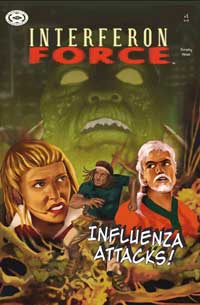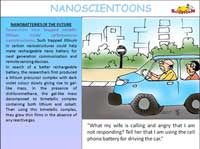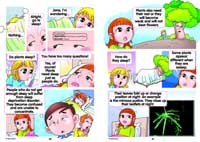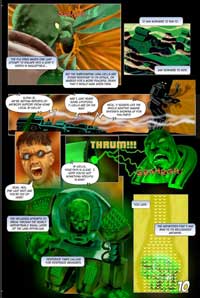Science comics and cartoons Inspire article
Comics have generally been considered as nothing more than a cheap pastime. However, Mico Tatalovic suggests some useful comics to help promote and explain science to students.

Shujath, Edward Dunphy and
Max Velati
There is an increasing amount of evidence that comics and still cartoons can be useful when teaching science. Children enjoy reading comics, and both the visual appeal of the artwork and the intriguing narrative (which can be humorous and educational) make comics an excellent medium for conveying scientific concepts in an interesting way.
As scientists have become aware of this novel and appealing form of engaging with young people, a variety of educational science comics and cartoons has been produced and is now available for teachers to ‘spice up’ their science lessons. Some examples of these comics and their associated websites are given here.
They can be used by teachers as a lesson starter, to determine students’ prior knowledge (such as existing scientific vocabulary, preconceptions and misconceptions), to motivate students to ask questions, and to help gauge students’ understanding of science topics by allowing them to produce their own comics and punchlines. With older groups, the comics could be set as preparatory homework for subsequent classroom discussion of the story’s scientific merit and credibility.
Unless indicated otherwise, all of the following resources are free.
General science
Newton and Copernicus
These are short comic strips about two lab rats whose conversations can motivate students to think about science and research: www.newtonandcopernicus.com
A description of how to use these cartoons in the classroom can be found at: www.csun.edu/~jco69120
Scientoons

Srivastava
Indian scientist and science communicator Pradeep Srivastava has created cartoons embedding new research, ideas, data or scientific facts within the caricatures, satirical comments or dialogue: www.scientoon.com
Planet Super Powers
Created by Planet Science, The Battle for the Planet Science comic includes a competition to ‘engineer’ your own superhero. A teacher’s pack and activities are also available: www.planet-science.com/randomise/index.html?page=
/psp/home.html&page=/psp/index.html
The Adventures of Archibald Higgins
This adventure series is the brainchild of French astrophysicist Jean-Pierre Petit, and the comics cover many advanced science topics in many languages: www.savoir-sans-frontieres.com
Concept Cartoons
These are single-frame cartoons that depict a single problem, such as ‘Would a snowman melt faster, slower or at the same rate if we put a coat around it?’. Offering no immediate solution, these cartoons make students think about the problem and discuss it. There are a few free examples online and the complete collection can be ordered in English and Welsh, as books, posters, photocopiable cartoons or a CD-ROM, from: www.conceptcartoons.com
The Young Scientists

Scientists, Singapore – a
science comic magazine
series for children
(www.theyoungscientists.in)
This comic book magazine, aimed at 5-13-year-olds, communicates science and the life stories of great scientists and promotes creative thinking and practical experimental skills. You can order the books and download sample issues from: www.theyoungscientists.in/products.html
Max Axiom
These comics cover a variety of topics from electromagnetism to natural selection and are aimed at students aged 8-14. They feature the superhero Max Axiom who ‘will do whatever it takes to make science super cool and accessible’. Copies can be ordered from: www.capstonepress.com/aspx
/pDetail.aspx?EntityGUID=8bd6f56b-a478-44aa-ba47-93b69dce0b27
Jim Ottaviani’s comics and graphic novels
Nuclear engineer Jim Ottaviani’s comics include Dignifying Science (why women are underrepresented in science), Suspended in Language (Niels Bohr’s life and scientific discoveries), Fallout (science and politics of the first atomic bombs), Two-fisted Science (the history of science), Levitation (psychics and psychology of magic), Wire Mothers: Harry Harlow and the Science of Love (the science of love) and Charles R. Knight: Autobiography of an Artist (the story of an artist whose paintings influenced 20th century scientific fact and fiction). The books can be ordered from: www.gt-labs.com
Big Time Attic comics and graphic novels
Zander and Kevin Cannon have illustrated non-fiction graphic novels such as Bone Sharps, Cowboys and Thunder Lizards (scientists who discovered dinosaur fossils), The Stuff of Life (all about DNA) and T-Minus: The Race to the Moon (astronomy). Their books can be ordered from: www.bigtimeattic.com

Shujath, Edward Dunphy and
Max Velati
Biology, health and medicine
Interferon Force
An exciting story about the battle between the immune system’s interferon molecules and flu viruses. Free hard copies are also available from: www.interferonforce.com
Adventures in Synthetic Biology
A good introduction to genetic modification and similar topics, available in English and Spanish: http://openwetware.org/wiki/Adventures
The Conundrum of the Killer Coronavirus
A two-page comic all about severe acute respiratory syndrome (SARS): www.biotechinstitute.org/resources
/YWarticles/14.1/14.1.3.pdf
World of Viruses
Graphic novels developed by the University of Nebraska in Lincoln, Nebraska, USA, which each present advanced scientific material about various viruses. You can download a sample and order the books here: worldofviruses.unl.edu/comics/
Friends Forever – A Triumph Over TB
A story illustrated in comic form for patients with tuberculosis, which aim to raise awareness of the disease: www.nyc.gov/html/doh/downloads/pdf/tb/tb-patient-comicbook.pdf
Luís Figo and The World Tuberculosis Cup
An educational comic book featuring a celebrity footballer and his support of the Stop TB Partnership to raise awareness of tuberculosis: www.stoptb.org/global/people/ambassadors/figo/world_tb_cup.asp
X-Men Life Lessons
This comic book can be used to help young people who have survived serious burn injuries, and comes with a discussion booklet: www.starlight-digital.org/burns-x-men-comic
Medikidz
A group of five superheroes are followed on a journey around Mediland (the human body) so that young people can learn about medical issues. The books can be ordered via the website, which also provides additional resources for children on medicine: www.medikidz.com
Jay Hossler’s comics and graphic novels
Jay Hossler, Assistant Professor of Biology at Juniata College, Huntington, Pennsylvania, USA, has written and illustrated graphic novels such as Clan Apis (bee behaviour), Sandwalk Adventures (how natural selection works and how it differs from creation stories) and Optical Allusions (eye biology and evolution). You can read some of the shorter comics online and order the graphic novels from his website: www.jayhosler.com
Cardiocomic
In 2009, the Centre d’Investigació Cardiovascular (Cardiovascular Research Centre, CSIC-ICCC) in Barcelona, Spain, ran its first competition for school students to draw cartoons about cardiovascular disease. You can find the cartoons in Spanish and Catalan, as well as details on the 2010 competition, here: cardiocomic.blogspot.de
Menudos corazones
The Spanish ‘Menudos corazones’ foundation for children and young people with cardiopathies has edited three comics on the topic to help these youngsters cope better with their situation: www.menudoscorazones.org/index.php
?option=com_content&task=view&id=295&Itemid=122&lang=es
Chemistry
Selenia
This chemistry comic series is designed to teach chemistry to pupils aged 7-10. Each issue covers a single subject, has an engaging narrative that explains the science involved, and features a glossary explaining the scientific terms: www.sciencecomics.uwe.ac.uk
Vladimir Prelog
A Croatian chemistry comic: http://prelog.fkit.hr/program/popularizacija/Prelog_strip.pdf
Physics, astronomy and space science
Cassini-Huygens: a probe to Titan
On 14 January 2005, the European probe Huygens entered the atmosphere of Titan – one of Saturn’s moons. Based on this major event in space exploration, the European Space Agency (ESA) has developed a comic book with supporting fact sheets for teachers to use in the classroom. They are available in Dutch, English, Finnish, French, German, Spanish and Swedish. See: www.esa.int/SPECIALS/Education/SEM6ZC9FTLF_0.html
Cindi in Space
A superhero style comic about the ionosphere and satellites, available in English and Spanish: http://cindispace.utdallas.edu/education/cindi_comic.html
The STEL Mangas
The Solar-Terrestrial Environment Laboratory (STEL) of Nagaya University in Japan has produced a series of eight Manga comics on topics such as global warming, solar radiation, geomagnetism and cosmic rays. The comics are freely available in English and Japanese and for translation into other languages: www.stelab.nagoya-u.ac.jp/ste-www1/doce/outreach.html#anc_booklets
Environmental issues and agriculture
Ozzy Ozone
Produced by the United Nations Environment Programme, this interactive comic provides information and activities about the ozone layer, environment, climate change and the atmosphere: www.ozzyozone.org
Eco Agents
An interactive online comic created by the European Environmental Agency to engage students with topics such as ecology and sustainable energy: http://ecoagents.eea.europa.eu
Science Stories
Comic stories from the Rothamsted Research Institute, an agricultural research centre in Harpenden, UK, depicting researchers from the institute, in cartoon form, describing their areas of research: www.rothamsted.ac.uk/schools/ScienceStories
Water Heroes
A comic story and associated teaching activities produced by Environment Canada to teach students about freshwater ecosystems and conservation: www.on.ec.gc.ca/greatlakeskids/water-heroes-e.html
Using comics in the science classroom
The following articles offer suggestions on how to use comics in the science classroom.
- Keogh B et al. (1998). Concept cartoons: a new perspective on physics education. Physics Education 33: 219-224
- Tatalovic M (2009) Science comics as tools for science education and communication: a brief, exploratory study. Journal of Science Communication 8: A02. Free access at: http://jcom.sissa.it/archive/08/04/Jcom0804%282009%29A02/?searchterm=None
- Vilchez-Gonzales JM, Palacios, FJP (2006) Image of science in cartoons and its relationship with the image in comics. Physics Education 41: 240-249
- Weitkmap E, Buret F (2007). The Chemedian brings laughter to the chemistry classroom. International Journal of Science Education 29: 1911-1929
